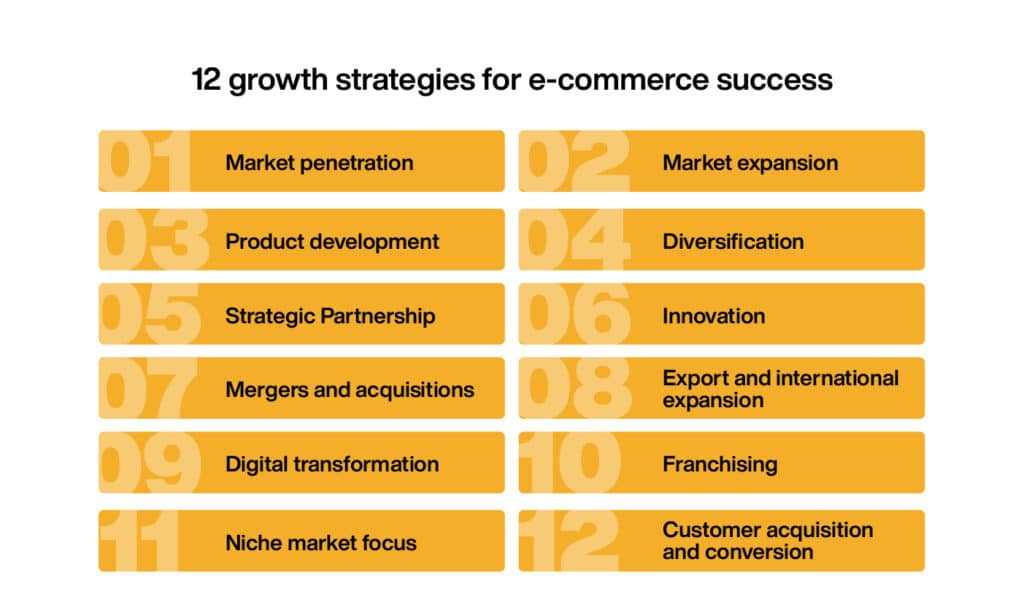Today, e-commerce has become a crucial foundation for businesses aiming for success and growth prospects. Keeping up with the latest trends in e-commerce is essential to staying competitive. Whether it’s the surge in mobile shopping or the incorporation of artificial intelligence (AI) and augmented reality (AR) technologies, the industry is always changing.
To fully utilize e-commerce, businesses need to implement effective marketing strategies that connect with their target audience, take advantage of social commerce, and use data analytics for personalized interactions. Additionally, it is vital to ensure that e-commerce platforms are optimized for smooth functionality and user-friendly experiences.
Let’s explore e-commerce trends that will drive the future of e-commerce.

Top 12 e-commerce trends
E-commerce is constantly evolving, driven by technological innovations and shifting consumer behaviors. Here are the top 12 trends shaping the future of online commerce:
1. Omnichannel retailing:
The integration of physical and digital retail experiences offers customers seamless shopping journeys. For instance, companies like Nike utilize their mobile app to complement in-store experiences, allowing customers to browse products, make purchases, and access exclusive content across channels.
2. Mobile commerce (M-commerce):
With the increasing use of smartphones, M-commerce continues to soar. Platforms like Shopify enable businesses to create mobile-responsive websites, ensuring a smooth shopping experience for users on various devices.
3. AI and personalization:
AI-powered algorithms analyze customer data to deliver personalized recommendations and experiences. Amazon’s recommendation engine suggests products based on browsing and purchase history, enhancing user engagement and driving sales.
4. Voice commerce:
Voice-activated devices like Amazon Echo and Google Home are revolutionizing how consumers shop. To cater to this growing trend, retailers are optimizing their websites for voice search and developing voice commerce capabilities.
5. AR shopping:
AR technology enables customers to visualize products in their real environment before making a purchase. IKEA’s AR app allows users to virtually place furniture in their homes, enhancing the online shopping experience and reducing returns.
6. Social commerce:
Social media platforms like Instagram and Facebook are increasingly becoming shopping destinations. Brands leverage shoppable posts and ads to directly sell products to their followers, tapping into a vast audience base.
7. Subscription e-commerce:
Subscription-based models offer convenience and personalized experiences to consumers. Examples include Birchbox for beauty products and Dollar Shave Club for grooming essentials.
8. Green e-commerce:
Sustainability is gaining prominence in e-commerce, with consumers prioritizing eco-friendly products and practices. Brands like Patagonia emphasize sustainable sourcing and offer repair services to reduce environmental impact.
9. Instant gratification:
Same-day and next-day delivery options satisfy consumers’ desire for instant gratification. Amazon Prime’s one-day delivery service sets a high standard for speedy fulfillment in e-commerce.
10. Blockchain technology:
Blockchain ensures transparent and secure transactions in e-commerce. OpenBazaar uses blockchain to create decentralized marketplaces, enabling peer-to-peer transactions without intermediaries.
11. Chatbots and AI-powered customer service:
Chatbots provide immediate assistance to customers, answering queries and guiding them through the purchase process. Shopify’s Kit bot assists merchants with marketing tasks, streamlining operations, and driving sales.
12. Influencer marketing:
Collaborating with influencers amplifies brand visibility and credibility. Brands like Fashion Nova leverage influencer partnerships to reach niche audiences and drive traffic to their e-commerce platforms.
12 growth strategies for e-commerce success
Let’s explore e-commerce marketing strategies to gain a better understanding:
1. Make your online store a heaven:
This method aims to offer customers an online shopping experience that is as smooth as shopping at physical stores. It involves developing a website that is user-friendly, visually appealing, and easy to navigate. Keeping up with evolving customer expectations and preferences requires constant improvement of the website. Think Amazon; they’re constantly making their website better, and guess what? People love it!
2. Go global:
Expand business operations globally by translating your website into various languages and forming partnerships with companies in diverse countries. This method allows entry into additional markets and customer groups, supporting business expansion and achievement. Similar to Alibaba, which has now become a globally recognized marketplace.
3. Be everywhere your customers are:
Acknowledge and meet customer preferences on different platforms, including online and in physical stores. This comprehensive approach guarantees that customers engage with the brand smoothly through various points of contact, improving convenience and satisfaction. Walmart is a great example of this. They’ve established several touchpoints to keep their customers happy.
4. Know your customers:
Use AI to analyze customer data and behavior patterns, allowing for customized recommendations and personalized shopping experiences. This is a data-focused strategy that increases customer interaction and happiness by showing them relevant products and content. eBay implemented this strategy, resulting in significantly increased customer engagement.
5. Mobile mania:
Ensure that your mobile application exemplifies excellence and user-friendliness, in response to the growing dependence on smartphones for shopping. By improving accessibility and functionality, businesses can increase user interaction and promote sales. Etsy updated its app to be more user-friendly, resulting in an improvement in user engagement rates.
6. Subscriptions:
Providing subscription-based options like curated boxes or tailored recommendations encourages repeat purchases and builds customer loyalty. This approach not only enhances user experience but also establishes lasting relationships with your customer base. Birchbox’s achievement with subscription boxes shows the attractiveness of this model in maintaining customers and creating reliable revenue channels.
7. Fast fashion:
Get your products to customers quickly. Creating effective production and distribution systems is essential for reducing lead times and meeting consumer expectations for quick delivery. Zara’s efficient supply chain management system allows for faster production cycles, ensuring that fashionable clothing items are available on time, optimizing inventory control.
8. Influencer power:
Engage with social media influencers to utilize their wide audience and trust in endorsing the brand and its products. By collaborating with influencers, companies can increase brand exposure and create excitement within specific consumer groups. Team up with social media stars to spread the word about your brand. Many brands, including Urbanic and Quench Botanics, have done this.
9. More choices:
The more you offer, the more people will buy! Increasing the range of products available to meet a variety of consumer tastes and provide more options for making purchases is the need of the hour. For example, Apple discovered that by diversifying their product offerings to include a wider range of devices and accessories, they were able to appeal to different customer preferences and enhance overall market share.
10. Checkout in a flash:
Nobody likes a complicated checkout process. Make it quick and easy. In addition to offering quality-curated products, streamlining the checkout procedure to minimize obstacles and facilitate smooth transactions for clients is equally essential. A more efficient shopping process, like the one seen on ASOS, decreases the number of abandoned carts and improves customer satisfaction.
11. Communication:
Consider incorporating voice assistant technology like Alexa to allow for voice-controlled ordering and customer interaction. Similar to Walmart’s strategy, this method leverages new technologies to enhance convenience and accessibility in shopping experiences.
12. Recommendations for the win:
Use smart algorithms to suggest items your customers will love, just like Netflix does with movies and shows. Developing smart recommendation systems using AI algorithms to recommend products that match customer preferences and browsing history boosts cross-selling chances and promotes repeat purchases through customized product recommendations. This strategy enhances customer engagement by tailoring the shopping experience to individual preferences, increasing the likelihood of customer satisfaction and loyalty.
How to optimize your e-commerce platform
To enhance sales and attract more customers, implementing effective e-commerce strategies is crucial. These include:
- Personalized shopping experience: Utilize data analytics to understand customer preferences and behavior. Offer personalized product recommendations, tailored discounts, and targeted marketing campaigns to enhance engagement and drive sales.
- Mobile optimization: Implement responsive design, fast loading times, and user-friendly navigation to provide a seamless mobile shopping experience.
- Streamlined checkout process: Implement one-click checkout options, guest checkout, and multiple payment methods to make the purchasing process quick and convenient for customers.
- Social commerce integration: Leverage social media platforms to reach a wider audience and drive traffic to your e-commerce site. Use shoppable posts, influencer collaborations, and social media advertising to promote products and encourage purchases directly from social platforms.
- Content marketing and SEO: Create high-quality content, including product descriptions, blog posts, and how-to guides, to attract organic traffic to your website.
- Customer reviews and testimonials: Encourage customers to leave reviews and testimonials to build trust and credibility. Displaying positive reviews and ratings on product pages can influence purchasing decisions and reassure potential customers about the quality and reliability of your products.
- Abandoned cart recovery: Implement automated email campaigns to recover abandoned carts and encourage customers to complete their purchases. Send personalized reminders and offer incentives such as discounts or free shipping.
Start your career with online management with Online Manipal
Start your e-commerce career through the online Bachelor of Commerce (BCom) and Master of Commerce (MCom) programs offered by Manipal University Jaipur (MUJ). With experienced faculty, extensive e-libraries, and flexible scheduling, including live and recorded classes, students can continue working and managing their other commitments while pursuing their academic goals.
Conclusion
Recognizing e-commerce growth opportunities alongside emerging trends is essential. Mastery of e-commerce marketing strategies and optimizing platforms ensures competitiveness. Looking forward, the future of e-commerce holds promises of sustainability, AI integration, and seamless user experiences.
Key Takeaways:
- E-commerce is evolving rapidly, driven by trends like mobile shopping and AI integration. Key trends include omnichannel retailing, AI-driven personalization, voice commerce, AR shopping, social commerce, subscription models, and blockchain technology.
- Winning strategies encompass creating user-friendly websites, global expansion, omnichannel presence, AI-driven personalization, mobile optimization, subscription models, fast fashion, influencer marketing, product variety, streamlined checkout, voice commerce, and recommendation systems.
Prepare for your next career milestone with us












